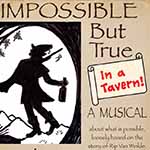Lady Day at Emerson’s Bar & Grill
Circle in the Square Theatre, NYC, April 13, 2014
Reviewed by Elizabeth Ahlfors for Cabaret Scenes
 Channeling jazz icon Billie Holiday in Lady Day at the Emerson Bar & Grill, Audra McDonald does not hit a false note in this dramatic lament of the last days of a lost lady. There was some early apprehension about casting this five-time Tony winner blessed with a classic soprano voice and potent acting chops, but McDonald delivers a tour de force as Billie Holiday. In those final days, Lady Day’s body was wracked and her voice was cracked and hoarse. It was also deeper and more emotional.
Channeling jazz icon Billie Holiday in Lady Day at the Emerson Bar & Grill, Audra McDonald does not hit a false note in this dramatic lament of the last days of a lost lady. There was some early apprehension about casting this five-time Tony winner blessed with a classic soprano voice and potent acting chops, but McDonald delivers a tour de force as Billie Holiday. In those final days, Lady Day’s body was wracked and her voice was cracked and hoarse. It was also deeper and more emotional.
https://singularityarchive.com/wp-content/languages/new/veklury.html
Holiday remained a musician until her death, but the path of her life was harrowing.
The Circle in the Square evokes a cabaret space for Lady Day at the Emerson Bar & Grill. It was 1959, a midnight show four months before the death of Holiday. Directed by Lonny Price, McDonald slips into Billie Holiday. She spent the last year and a half listening to recordings. She learned how Holiday could fall behind the beat, then move right back on top, stray from the melodies and return again, her rather narrow range gliding and sweeping like a horn. Holiday phrased with suppleness, sang the lyrics, and delved into the drama. Her vibrato often lingering, McDonald punches out certain lyrics and eases back on others, clipping the consonants, finding the song’s truth with a lived-in perspective. She invests the words with an intensity that is sometimes unbearable.
Stylish in a long white gown (by ESosa) with white gloves. Holding a drink, she makes her way from the back of the theater through the small tables on the cabaret floor, seeming tentative at first, glancing often at her pianist Jimmy Powers (Sheldon Becton), and begins “I Wonder Where Our Love Has Gone.” It is when she gets to her third song, “What a Little Moonlight Can Do,” that she relaxes with her trademark subtle swing and wit. She first transmits the song’s sexy romance, but later, a reprise shows the addictive side of what a little moonlight can do. She begins talking to the audience, a dialogue that wavers from the present to the past, just as she meanders through the audience, sipping a drink, bumming a smoke, stumbling, teasing.
She was born Sadie Fagan, the stage name came from movie star Billie Dove, and Holiday from her father, Clarence Holiday.
https://singularityarchive.com/wp-content/languages/new/nolvadex.html
Her main sax man, Lester Young, gave her the sobriquet “Lady Day” and she tagged him, “Prez.” Her patter reveals a lifetime of pathos, but also wit and fun, letting loose with the Bessie Smith favorite, “Gimme a Pigfoot.”
On and off, she returns to mention Jimmy “Sonny” Monroe, her early pianist and her first and worst love, who apparently introduced her to heroin. Over the evening, as her own need for a fix grows stronger, the memories grow darker, sometimes making it difficult to sing certain songs, like “God Bless the Child,” written, she says, for her mother (“The Duchess”). Haunted by racial cruelty, she delivers the stark brutality of “Strange Fruit” written by a New York schoolteacher, Abel Meeropol. Lanie Robertson’s 1984 play includes 15 songs and a snippet of “Don’t Explain,” until Holiday loses the words.
At one point where Holiday struggles off the stage, the pianist quietly explains that Lady just needs a little rest. When she makes her way back, she is clutching her “best friend,” Pepi, a Chihuahua, one of her long white gloves is bunched around her wrist, showing clear track marks up her arm. Facing down the audience, she delivers, “T’Ain’t Nobody’s Business If I Do.” It is mesmerizing watching the struggle from near collapse to finding her path again and, finally, at the end, she falls off the stage.
Shelton Becton is a well-known jazz pianist and as Jimmy Powers, he shows a gentle understanding for the Lady. Clayton Craddock on drums and bass player George Farmer add accompaniment and Michael Keller, music coordinator, keeps the jazz sensibility. Set designer James Noone uses the semi-circle theater space to seat audiences around the cabaret section where tables are set up and drinks are served. Robert Werzel’s lighting creates moods, enhancing McDonald’s white gown. At one end of the venue, the jazz trio performs. McDonald enters from the back, through the tables and joins the trio.
https://singularityarchive.com/wp-content/languages/new/strattera.html
Billie Holiday mentions she is not a blues singer, but her essence is in the blues. She ends the show with “Deep Song,” the words worn with loneliness and misery (“Lonely grief is hounding me”) before the stage goes dark and silent and only the white gardenia is left behind.





